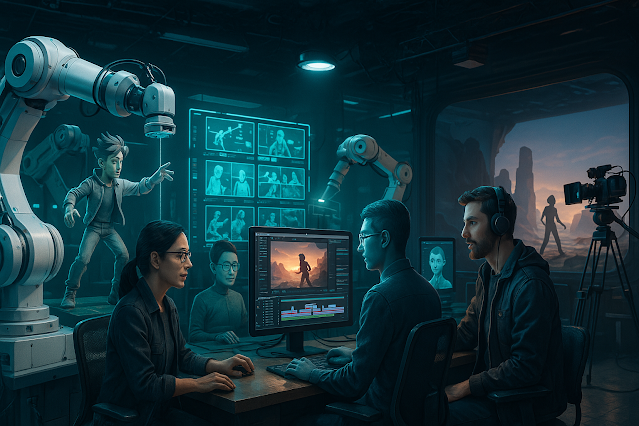The film and animation industry is experiencing a technological revolution — and at the heart of it is artificial intelligence (AI). From scriptwriting to post-production, AI is reshaping the way films are made, accelerating creative workflows, cutting production costs, and unlocking new forms of storytelling. This article explores how AI is transforming the world of cinema and animation, and what this means for filmmakers, studios, and audiences alike.
1. AI in scriptwriting and story development
AI is no longer just a tool for production — it’s increasingly involved at the earliest stages of film creation: writing the script. Tools like ChatGPT, Sudowrite, and ScriptBook can help writers brainstorm plots, generate character dialogue, and even predict a script's success based on market data.
-
Predictive analysis: AI can analyze vast amounts of past box office data and viewer preferences to recommend themes, genres, or character arcs likely to perform well.
-
Idea generation: Writers can use AI to generate multiple storylines, alternative scenes, or creative plot twists to enhance their narrative.
Example: Netflix reportedly uses AI to analyze audience preferences and greenlight projects with the highest probability of success.
2. AI in previsualization and storyboarding
Previsualization (or "previs") involves creating rough versions of scenes before actual filming begins. AI-assisted tools are now helping directors and animators visualize scenes in real time.
-
Automated storyboarding: AI can turn scripts into storyboard panels, complete with characters, settings, and camera angles.
-
Motion capture enhancement: AI improves motion capture by filling in missing movements, refining facial expressions, and reducing the need for expensive reshoots.
Tools like NVIDIA’s Omniverse and Unreal Engine with AI integrations are making it easier to create immersive, real-time 3D environments for previs and animation.
3. AI in Animation and Visual Effects (VFX)
AI is supercharging animation workflows, making it possible to produce high-quality visuals faster and with fewer resources.
-
Automated in-betweening: AI fills in the frames between key animations, saving time for animators.
-
Style transfer: AI can apply artistic styles to animation frames, mimicking hand-drawn aesthetics or adjusting the look of scenes in real time.
-
VFX automation: Complex effects like fire, water, smoke, and explosions can now be generated or enhanced with AI, reducing manual labor.
Example: Disney uses AI tools to assist in rotoscoping — separating characters from backgrounds — a task that used to take weeks.
4. AI in voice acting and dubbing
AI-generated voices and voice cloning technology are now capable of creating realistic voice performances from text.
-
AI voice synthesis: Tools like Descript’s Overdub, ElevenLabs, and Replica Studios create lifelike voiceovers without the need for a human actor.
-
Automated lip-syncing: AI can adjust character lip movements to match dubbed audio, making localization more seamless across languages.
This has enormous implications for international releases, enabling quicker, high-quality dubs and localized animations.
5. AI in Editing and Post-Production
Editing is traditionally a labor-intensive process. AI is helping editors work faster and smarter.
-
Smart editing assistants: AI can automatically identify the best takes, remove silences, or even detect emotional tone and match music accordingly.
-
Color grading: AI tools like DaVinci Resolve’s Neural Engine can automate color matching and correction.
-
Restoration and enhancement: AI is used to upscale old footage, remove noise, or even colorize black-and-white films.
6. AI for Audience Personalization and Marketing
After the film is made, AI continues to play a role in how it’s distributed and marketed.
-
Trailer generation: AI can analyze a film and automatically create a trailer by selecting the most engaging scenes.
-
Audience targeting: Machine learning helps studios target specific audiences with personalized ads, increasing engagement and ROI.
-
Content recommendation: Platforms like Netflix and YouTube use AI to tailor what viewers see based on behavior and preferences.
7. The Ethical and Creative Implications
While AI offers incredible advantages, it also raises important questions:
-
Will AI replace human creativity? Most experts believe AI is a collaborator, not a creator. It supports human imagination rather than replacing it.
-
What about job displacement? Some roles may evolve or become obsolete, but new roles are emerging in AI supervision, data wrangling, and AI-driven storytelling.
-
Deepfakes and misuse: AI-generated faces and voices can be used unethically. The industry is working on watermarking and regulations to prevent misuse.
Final thoughts
AI is not the future of filmmaking — it’s already here. As AI continues to evolve, the boundaries between technology and creativity will blur even further, enabling filmmakers to tell more ambitious stories with fewer limitations. For animators, editors, and storytellers, embracing AI isn’t just an option — it’s becoming a necessity to stay competitive and innovate in an ever-changing media landscape.

Comments
Post a Comment